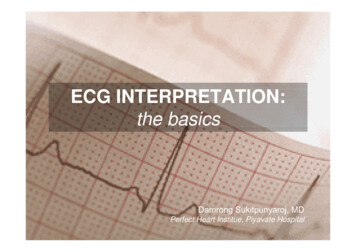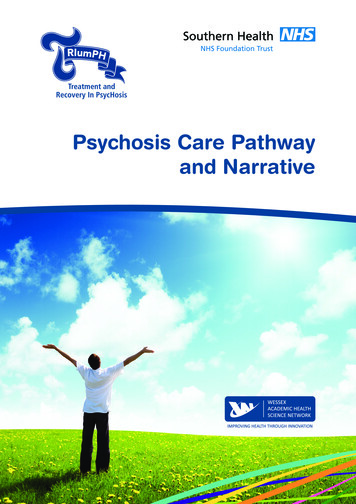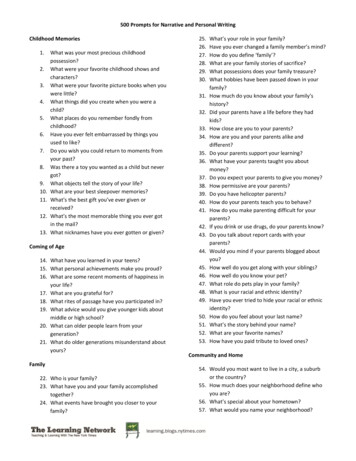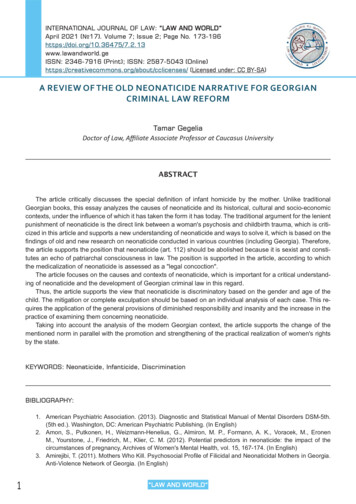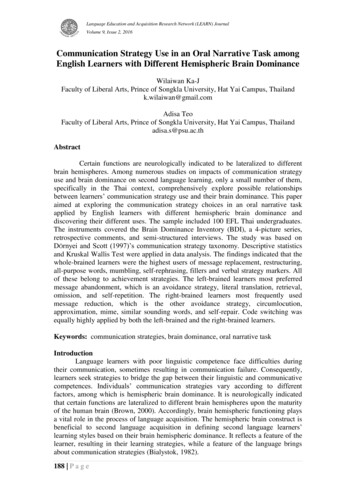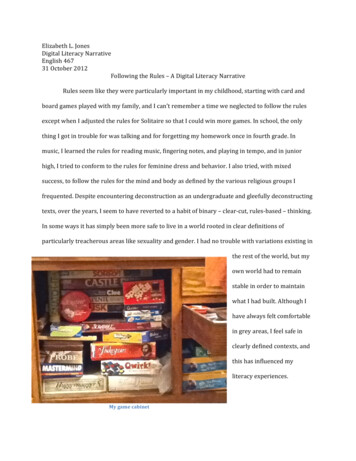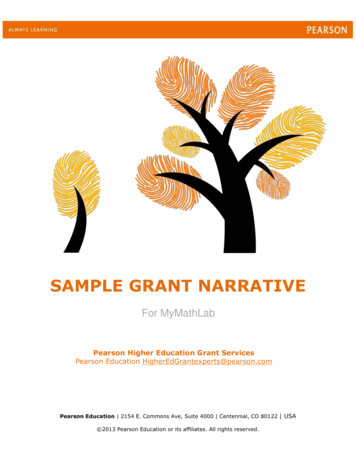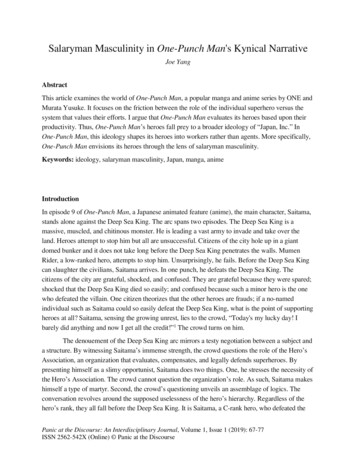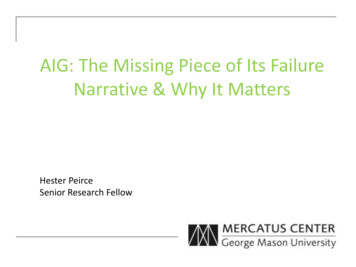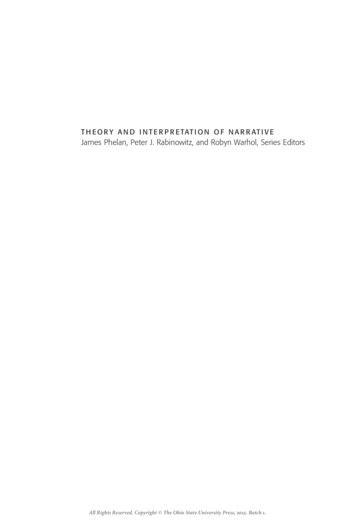
Transcription
T h e o r y a n d I n t e r p r e tati o n o f N a r r ati v eJames Phelan, Peter J. Rabinowitz, and Robyn Warhol, Series EditorsAll Rights Reserved. Copyright The Ohio State University Press, 2015. Batch 1.
All Rights Reserved. Copyright The Ohio State University Press, 2015. Batch 1.
Narrative PathsAfrican Travel in Modern Fictionand NonfictionKai MikkonenT H E O H I O S TAT E U N I V E R S I T Y P R E S S COLUMBUSAll Rights Reserved. Copyright The Ohio State University Press, 2015. Batch 1.
Copyright 2015 by The Ohio State University.All rights reserved.Library of Congress Cataloging-in-Publication DataMikkonen, Kai.Narrative paths : African travel in modern fiction and nonfiction / Kai Mikkonen.pages cm. — (Theory and interpretation of narrative) Includes bibliographical referencesand index.ISBN 978-0-8142-1274-5 (hardback) — ISBN 978-0-8142-9379-9 (cd-rom)1. Travelers’ writings, European—History and criticism. 2. European fiction—History and criticism. 3. Narration (Rhetoric) 4. Postcolonialism in literature. 5. Africa—In literature. I. Title.PN56.T7M55 2015809'.93355—dc232014033910Cover design by Laurence J. NozikText design by Juliet WilliamsType set in Adobe Minion ProPrinted by Thomson-Shore, Inc.The paper used in this publication meets the minimum requirements of the American National Standard for Information Sciences—Permanence of Paper for Printed Library Materials.ANSI Z39.48–1992.987654321All Rights Reserved. Copyright The Ohio State University Press, 2015. Batch 1.
ContentsList of IllustrationsviiAcknowledgmentsixIntroductionPart IFactual Places and Fictional Routes1Narrating and Describing West Africa 1 The Enchanted Arrival: Passage into West Africa in the Travel Writings ofBlaise Cendrars, André Gide, and Graham Greene412 The Rhetoric of the Mad African Forest in Joseph Conrad,Louis-Ferdinand Céline, and Graham Greene693 Travel Narrative between Spatial Sequence and Open Consequence inGraham Greene’s Journey Without Maps88Part II Travel Writing and the Novel4 The Immediacy of Reading: André Gide’s Travel Fact and Travel Fictions1135 The Incongruous Worlds of Evelyn Waugh’s Ethiopia1476 A Critique of the African Picturesque in Georges Simenon’s TravelReportages and Novels183All Rights Reserved. Copyright The Ohio State University Press, 2015. Batch 1.
vi ContentsPart III Inventions of Life Narrative7 Virtual Genres in Pierre Loti’s and Joseph Conrad’s African TravelDiaries and Fiction2218 Out of Europe: The African Palimpsest in Michel Leiris’s L’Afrique fantôme 2409 Africanist Paradoxes of Storytelling in Karen Blixen’s Out of AfricaIn ConclusionFiction, Colonial Travel Narrative, and the Allegorist266292References305Index317All Rights Reserved. Copyright The Ohio State University Press, 2015. Batch 1.
List of IllustrationsFigure 1 Map of Ubangi-Shari and Chad, showing André Gide’s routebetween August 1925 and May 192652Figure 2 Map of Liberia, showing Graham Greene’s route in thespring of 193594Figure 3 Map of East Africa, showing the places that Evelyn Waughvisited between October 1930 and March 1931158–59Figure 4 Fictional map from Black Mischief by Evelyn Waugh164Figure 5 Map of Georges Simenon’s travel through Africa in thesummer of 1932184Figure 6 Map of the River Congo from Norman Sherry’s Conrad’sWestern World, showing Conrad’s route from Boma toStanley Falls and back between June and December 1890230Figure 7 Map of Mission Dakar-Djibouti (May 1931–February 1933)243Figure 8 The stork figure in the story “The Roads of Life” in KarenBlixen’s Out of Africa269viiAll Rights Reserved. Copyright The Ohio State University Press, 2015. Batch 1.
All Rights Reserved. Copyright The Ohio State University Press, 2015. Batch 1.
AcknowledgmentsT h e i d e a for this book originated in the fall of 2002 when I had the opportunity to spend a month at the Finnish-African Cultural Centre Villa Karoin Grand-Popo, Benin. The many signs of the colonial era that I took note ofin Benin and Togo inspired me to explore the ways in which the Europeantravel writers perceived sub-Saharan Africa in the heyday of colonialism. Iam grateful to the managers and the staff of Villa Karo, and the many localpeople, who made this eye-opening visit possible, as well as to my wife Almafor her company during our many memorable excursions in this region.Without the three years I spent at the Helsinki Collegium for AdvancedStudies in 2003–2006, this book would not have been written. It was a greatprivilege to focus on research for this time and benefit from discussions withstellar scholars from various fields in the humanities and other fields.Many people have read parts of the book in the course of its development. In the early stages of the work, discussions with David Scott in Helsinki and Dublin, and David’s insightful reactions to my work, encouragedme to pursue the project. I also owe debts of gratitude to a number of friendsand colleagues in English Philology at the University of Helsinki. I must particularly acknowledge John Calton’s helpful readings of earlier drafts of thiswork, his ideas about a possible title for the book, and his genuine interest in my research during the last years of the writing process. I am alsothankful to Howard Sklar, Mark Shackleton, and Laurel Bush, a specialist ofixAll Rights Reserved. Copyright The Ohio State University Press, 2015. Batch 1.
x Acknowledgmentstravel writing, from the same unit, for reading parts of the work and for theirencouragement. Furthermore, I would like to express gratitude for the helpthat I have received from the University of Helsinki Language Centre whilepreparing conference papers or articles on this topic over the years. The Centre’s hawkeyed proofreaders have included–with apologies to anybody I mayhave omitted–Glenda Dawn Goss, Nancy Seidel, and Marlene Broemer. I alsowish to thank Alan Prohm for his stylistic comments in the beginning of thisproject. The many conferences where I have presented parts of this work aretoo numerous to mention, but I must acknowledge the tremendous importance of my colleagues’ feedback on these occasions. In particular, I need tothank Françoise Lavocat for her co-operation in organizing the workshop“Transworld Travel” at the ICLA XIXth World Congress, Seoul, South Korea,in August 2010. The book has also greatly benefited from two courses ontravel literature that I have given in comparative literature at the University ofHelsinki in 2007 and 2012. I owe a great debt to my students whose questions,essays, and course diaries helped me to clarify my ideas.I offer the most heartfelt thanks to the editors of the TIN series of TheOhio State University Press, Peter J. Rabinowitz and Robyn Warhol, and thetwo anonymous readers of this series, whose feedback has been the most helpful, generous, and encouraging that I have received in my academic careerthus far. I also wish to express my gratitude to the editors of the OSU Press,Sandy Crooms, Lindsay Martin, Katie Gucer, and Tara Cyphers, for theirinvaluable assistance. Special thanks also to Brian Richardson for his encouragement and interest in my work.Portions or earlier versions of Chapters 1, 2, 3, and 7 first appeared in thejournals Narrative 15.3 (2007), Comparative Critical Studies 5.2–3 (2008), Studies in Travel Writing 15.1 (2011), and Neohelicon 40.2 (2013). I would like toexpress my gratitude to the publishers of these journals for their permissionto reproduce this material here. I am also very grateful to the editors, JimPhelan, Robert K. Weninger, and Tim Youngs, as well as Peter Hajdu andthe anonymous peer-reviewers, for their precious feedback, stimulus, andsupport.All Rights Reserved. Copyright The Ohio State University Press, 2015. Batch 1.
IntroductionFactual Places and FictionalRoutesTo speak of “literary traveling” is almost a tautology, so intimately are literature and travel implicated with each other. Any child senses this, andany adult recalling his childhood remembers moments when reading wasrevealed to be traveling.—Paul Fussell, Abroadbody of writing that is called “travel literature” has traditionally set up conflicting expectations of empirical objectivity and subjectiveexperience. In other words, the travel account reveals not only the facts ofsome geographical place but also the personal significance of the travel experience. There is an inherent potential in travel writing to be thought of bothin terms of a concrete spatial configuration and as happening to someone hereand now, something that is unified in the traveller’s personal experience andrecounting. Some of the tension between the demands for empirical observation and the requirement that the travelogue capture the reader’s attentionthrough the personality of the writer’s voice or the marvels in the descriptionmay also be reflected in the deep formal ties that have existed between travelliterature and the modern novel. One of the most prominent members of theRussian formalist school of literary theory, Roman Jakobson, argued in hisinfluential essay “The Dominant” (1935) that travelogues, as a kind of transitional genre and one form of intimate literature, served an important functionin the development of modern fiction: “In certain periods such genres areevaluated as extraliterary and extrapoetical, while in other periods they mayfulfil an important literary function because they comprise those elementswhich are about to be emphasised by belles lettres, whereas the canonicalThe amorphous1All Rights Reserved. Copyright The Ohio State University Press, 2015. Batch 1.
2 Introductionforms are deprived of these elements” (Jakobson 1987, 45). Jakobson’s argument is based on the observation that the travelogue contributed in certainessential ways to the development of the Russian novel in the early nineteenthcentury. Among these contributions was, in particular, the intimate point ofview of an individual who lives and travels in the contemporary world andmakes subjective observations about that world.Typically, travel writing conceptualizes space in terms of perpetual movement, while it organizes events and experiences around the temporal structure of the journey mediated through the traveller’s consciousness. The samebasic structure is common in various forms of modern fiction, such as theadventure or the realist novel, which is structured around a journey plot.Much of the narrative potential of travel lies in the fact that we recognize init temporal and spatial structures that call for narration. The different stagesof travel—departure, voyage, and return—provide the narrative with basictemporal structures that make the reader expect certain things to happen.1Furthermore, in the history of the modern novel, travel writing, and especially the accounts of travels to distant lands, has helped to shape the genrein terms of a credible foreign milieu and the description of foreign cultures.2In his Travel Literature and the Evolution of the Novel (1983), Percy G. Adamshas demonstrated how such central characteristics and expectations of travelwriting as realist décor, foreign settings, and minutely detailed description,were exported to fiction in the seventeenth and eighteenth century, thus making a central contribution to the origins of the modern novel. At this time,moreover, novels started mixing realist description with personal reflectionin ways similar to travel literature (Adams 1983, 108–109; Chupeau 1977, 548;Bradburn 2011, 145–50).3 The description of foreign places and exotic formsof life in travel literature thus helped, on the one hand, to authenticate the1. In narrative and literary studies, it is a kind of commonplace to suggest, with Michelde Certeau, that “every story is a travel story—a spatial practice” (1984, 115). For instance,the chronotope of the road, and the metaphor of “the path of life” that it realizes, is a centralfeature in Mikhail Bakhtin’s history of novelistic plot patterns and is especially important forwhat Bakhtin calls the adventure novel of everyday life (1981, 120). On the uses of the travelmetaphor in narrative theory, and the implications of the conceptual metaphor of NARRATIVE IS TRAVEL, see Mikkonen 2007a. On the same conceptual metaphor, see also Bradburn2011.2. We have to keep in mind, however, that perhaps the most prototypical form of travelwriting is not a narrative in itself but a travel journal and, furthermore, that travel writing oftenprioritizes description instead of narration.3. For Adams, both the literary travel story and the modern novel are based on an “imaginative reshaping of reality” (1983, 134), by which he means that the two genres are producedthrough “a conflict and an alliance between realism and romance,” or between truth claims andimagination (1983, 108–9).All Rights Reserved. Copyright The Ohio State University Press, 2015. Batch 1.
Factual Places and Fictional Routes 3emerging genre of the modern realist novel while, on the other hand, the distant and little known regions that were described in travel literature inspiredthe novelists to create more credible fictional foreign worlds or invent newworlds more freely (Adams 1983, 147). We can, for instance, think of RobinsonCrusoe (1719), in which Daniel Defoe used Alexander Selkirk’s true story andother actual travel accounts as his source material; Tobias Smollett’s The Expedition of Humphry Clinker (1771) where the author’s own travel experiences inScotland, France, and Italy provide much of the novel’s plot; or, as an example of travel writing that is heavily indebted to the novel, Laurence Sterne’sA Sentimental Journey (1768), famous for its episodic descriptions of placesand encounters on the road, based on the author’s travels through Franceand Italy. Furthermore, Swift’s Gulliver’s Travels (1726, 1735), by parodying thedescriptions and reports issued by travellers, explores the similarity betwee
Mikkonen, Kai. Narrative paths : African travel in modern fiction and nonfiction / Kai Mikkonen. pages cm. — (Theory and interpretation of narrative) Includes bibliographical references and index. ISBN 978-0-8142-1274-5 (hardback) — ISBN 978-0-8142-9379-9 (cd-rom) 1. Travelers’ writings, European—History and criticism. 2 . European .
